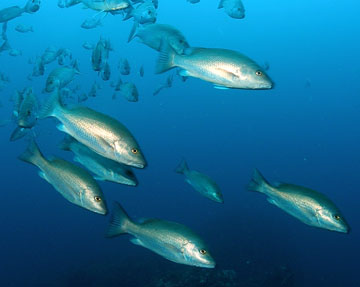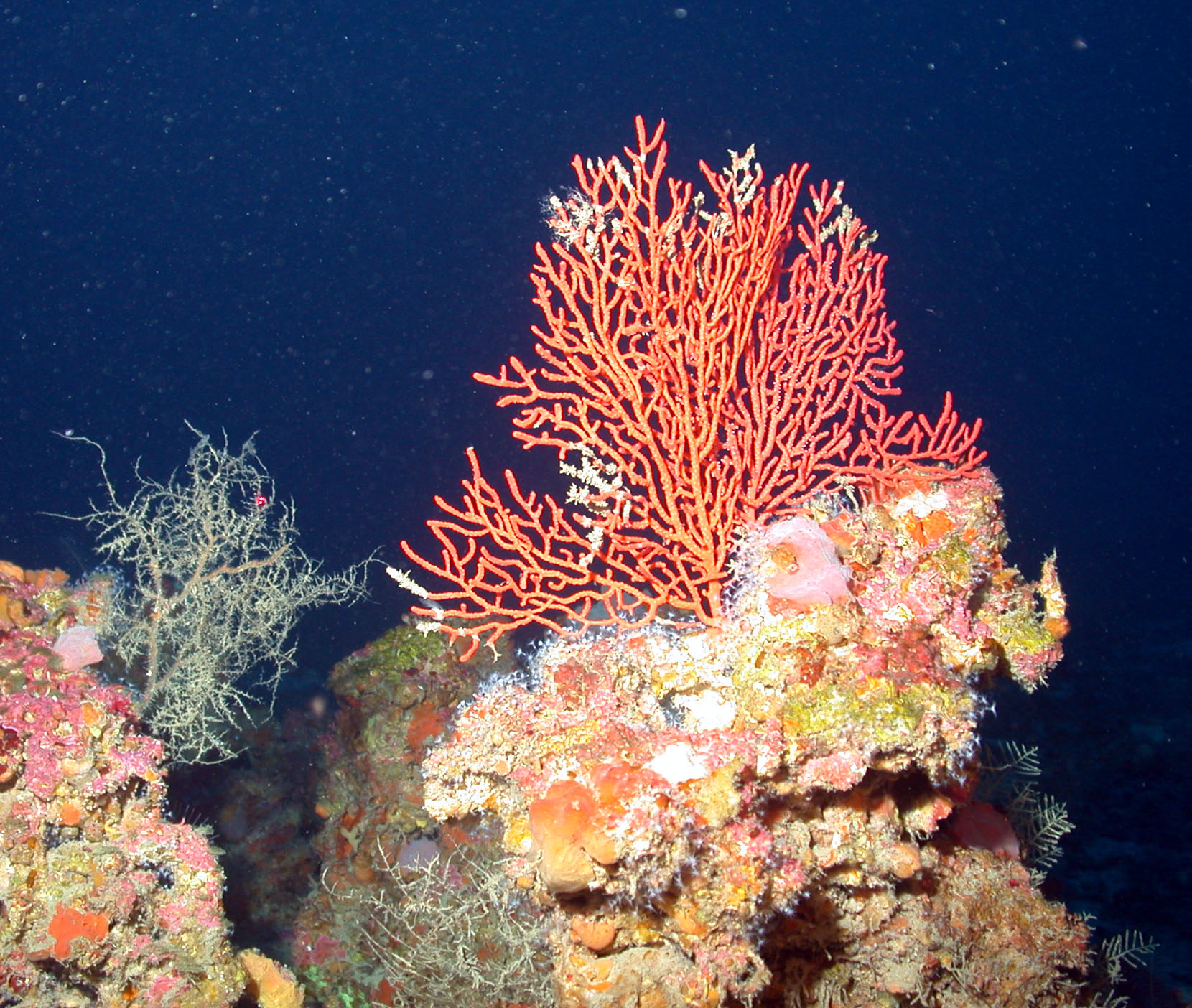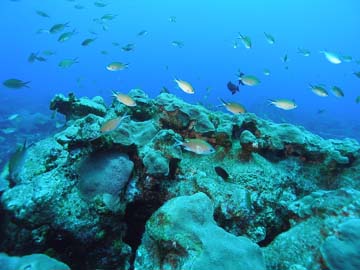For “Travel Tuesday”, let’s visit The Flower Garden Banks which is off the TX and LA coasts.
“Flower Garden Banks National Marine Sanctuary is one of 14 federally designated underwater areas protected by NOAA's Office of National Marine Sanctuaries, and the only site located in the Gulf of Mexico.”
“Situated 70 to 115 miles off the coasts of Texas and Louisiana, the Flower Garden Banks sanctuary includes underwater communities that rise from the depths of the Gulf of Mexico atop underwater mountains called salt domes.
The Flower Garden Banks (often simply the "Flower Gardens") is a U.S. National Marine Sanctuary in the northwestern Gulf of Mexico, located roughly 105 miles (170 km) south of Sabine Pass, Texas.

Two reefs, East Flower Garden Bank and West Flower Garden Bank, were part of the National Marine Sanctuary when it was created in 1992. In 1996, the smaller nearby Stetson Bank was added to the sanctuary.
Typical for coral reefs, the Flower Garden Banks contain a large number of aquatic species. Almost three hundred species of fish, twenty-one species of coral, several species of crustaceans, four dominant species of sponges, and a wide variety of sharks, skates, and ray. The loggerhead sea turtle is resident. Several resident whale sharks turn in frequent appearances; manta ray are also commonly sighted.”
HISTORY

From Snappers to Sanctuary
“The Flower Garden Banks were discovered by snapper and grouper fishermen in the late 1800's. They named the banks after the brightly colored sponges, plants, and other marine life they could see on the colorful reefs below their boats.
Deep
coral
habitat
around
the
banks.
-------
Mistaken Identity!
Sanctuary staff, answering phone: “Flower Garden Banks National Marine Sanctuary, how may we help you?”
Caller: “Hi, I'd like to send flowers to my daughter. She's graduating from Texas A&M next week. We are SO proud of her!”
Sanctuary staff: “Congratulations! I’m sorry we can’t help you, though. You see, this is not a flower shop. It’s a federal agency that protects a system of special underwater areas. This particular National Marine Sanctuary is located in the northwestern Gulf of Mexico. It has some great coral and sponge habitats, different types of fish, sea turtles...”
Caller: “Oops!”
-------
Discovery and Exploration
 “Little did the snapper fishers of old know how many future “educational moments” they were creating when they nicknamed a couple of favorite fishing spots the Texas Flower Gardens. From their discovery in the early 1900’s, to their designation as a National Marine Sanctuary in 1992, the Flower Garden Banks have come a long way. With proper management of human activities, the Flower Garden and Stetson Banks can be expected to continue providing enjoyment and wonder for humans and providing crucial habitat for marine life for years to come.
“Little did the snapper fishers of old know how many future “educational moments” they were creating when they nicknamed a couple of favorite fishing spots the Texas Flower Gardens. From their discovery in the early 1900’s, to their designation as a National Marine Sanctuary in 1992, the Flower Garden Banks have come a long way. With proper management of human activities, the Flower Garden and Stetson Banks can be expected to continue providing enjoyment and wonder for humans and providing crucial habitat for marine life for years to come.
Although fishers are believed to have discovered and named the Flower Garden Banks, the first recorded discovery did not occur until 1936. The Flower Garden and Stetson Banks were included in a hydrographic survey of the Gulf of Mexico, conducted by the U.S. Coast & Geodetic Survey (now the National Ocean Service, of which the National Marine Sanctuary 
-------
NATURAL SETTING

“Understanding the complexities of the sanctuary's local ecosystems requires learning about all of the components in its natural setting. This includes the underlying geology, a variety of habitats, the larger context of the Gulf of Mexico ecosystem and its watersheds, as well as the specific plants and animals found within the sanctuary.”
Schooling
fish
above
the
coral
cap.
-------
It's so hard to believe this is just off the Texas coast...
Words can’t describe this, so there are some videos:
Flower Garden Banks - Sharks and other Predatory Fish
“With over 200 hundred recorded species of fish, divers can see and swim with large sharks and other predatory fish throughout the year. Hammerheads, silky sharks, sandbars and dusky sharks are often encountered at the Flower Gardens, depending on the time of the year. These sharks and other large predatory fish like barracuda, are not only a thrill to see underwater, but also a vital part of the reef ecosystem.”
Flower Gardens with Tiger Shark, Aug 2012. This video previously contained a copyrighted audio track. Due to a claim by a copyright holder, the audio track has been muted.
Texas Gulf Treasures – Diving the Flower Garden:
The next three videos aren’t so colorful:
Flower Garden Banks - Part I
Flower Garden Banks - Part II
Flower Garden Banks - Part III
-------
Flower Garden Banks, Protect it!
“Flower Garden Banks National Marine Sanctuary lies 70 to 115 miles off the coasts of Texas and Louisiana where three banks emerge from the depths of the Gulf of Mexico.”
--------
I hope you enjoyed visiting the Flower Banks, without getting wet!
_______
On This Day:
Professional football is born, Aug 20, 1920:
![images[7] images[7]](https://blogger.googleusercontent.com/img/b/R29vZ2xl/AVvXsEjWVKeqbrdHhFkKiLVhSi80xy4ndTRTjuaHQRUBLVeSh6MpV8T2B8ka4FXoYDRVPJ6wTnYkZy5_-n0i5wx17MR520QWScCx6kaffN_cCUgQu77O9rNjp33_no5cO-PHfOtbfAD45xF1zvUC/?imgmax=800)
The APFA began play on September 26, with the Rock Island Independents of Illinois defeating a team from outside the league, the St. Paul Ideals, 48-0. A week later, Dayton beat Columbus 14-0 in the first game between two teams from the APFA, the forerunner of the modern NFL.”
_______
Record-setting tow-truck parade held in Washington State, Aug 20, 2004:

According to the International Towing and Recovery Hall of Fame and Museum in Chattanooga, Tennessee, the first tow truck was the invention of a Chattanooga native named Ernest Holmes, who helped his friend retrieve his Model T Ford after the car slid into a creek. Holmes had previously assembled a system consisting of three poles, a pulley and a chain, all connected to the frame of a 1913 Cadillac. Holmes soon patented his invention, and began manufacturing the equipment to sell to garages and other interested customers out of a small shop on Chattanooga's Market Street. The Holmes brand went on to earn an international reputation for quality in the towing industry.
On September 20, 2008, the Metropolitan New York Towing Association threw its own hat into the ring. Two hundred and ninety-two tow trucks, including flatbeds, wreckers and 50-ton rotators, left Shea Stadium in Queens (previously the home of the New York Mets, the baseball park has since been demolished to make way for the Mets' new Citi Field) and traveled along the Van Wyck Expressway and the Belt Parkway before ending up at an abandoned airport tarmac at Floyd Bennett Field in Brooklyn. There, the trucks parked in a formation that spelled out the words "New York."
_______
Yesterday:

The soffit was taken down when we we going to do a cantilevered extension, without a post. It should have been replaced before the framework for the roof extension was put up, but they didn’t do it. It will stop birds and bugs from getting in my attic. It was the next step, as Ray will have to paint it before the roof can go on.


I was “gopher”, so that kept me busy, going back and forth for different tools, plywood and screws. But we finally got it done. Thankfully, it wasn’t too hot yesterday.
![images[7] images[7]](https://blogger.googleusercontent.com/img/b/R29vZ2xl/AVvXsEj-gAX3PwdpUMRhrk9dDY1GMo7aHG1uzg6x9PZhdYaWKN1Ie87J24QklhDMQ2QGZ1An2sRcLx3MQVNsksZHOiQ4nvh4hFgXFhyphenhyphenpNJY3soZVpH77cv1QGqtvxczxtKX6CID2jklTEH-q3kB5/?imgmax=800)
![images[6] images[6]](https://blogger.googleusercontent.com/img/b/R29vZ2xl/AVvXsEjqQCNATbeimWSGr_By3kNjuven74hcP5QOba-TSofZzpyg6oQsuQXsVaoFUEnaSxMBeKkAQbq3N6NgR6imiWT7WA9Lqy6AoSWGENa6CsbAdR6W4elEJ5tpTOHuM5PdxJRg8Ncc7KHgaJ_0/?imgmax=800)



















2 comments:
My daughter-in-law has scuba dived in that "garden". She said it was awsome.
Thanks for your comment, DD
That would have been terrific, but I wouldn't want to go down there.
If you have any pictures of her visit to that "garden", maybe you could have us not 'wondering' what it is really like for the visiting scuba diver.
Happy Tails and Trails, Penny.
Post a Comment